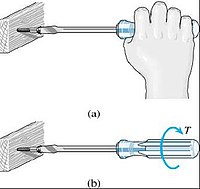
Photo from wikipedia
Over the evolution, humans have constantly developed and improved their technologies. This evolution began with the use of physical tools, those tools that increase our sensorimotor abilities (e.g., first stone… Click to show full abstract
Over the evolution, humans have constantly developed and improved their technologies. This evolution began with the use of physical tools, those tools that increase our sensorimotor abilities (e.g., first stone tools, modern knives, hammers, pencils). Although we still use some of these tools, we also employ in daily life more sophisticated tools for which we do not systematically understand the underlying physical principles (e.g., computers, cars). Current research is also turned toward the development of brain–computer interfaces directly linking our brain activity to machines (i.e., symbiotic tools). The ultimate goal of research on this topic is to identify the key cognitive processes involved in these different modes of interaction. As a primary step to fulfill this goal, we offer a first attempt at a common framework, based on the idea that humans shape technologies, which also shape us in return. The framework proposed is organized into three levels, describing how we interact when using physical (Past), sophisticated (Present), and symbiotic (Future) technologies. Here we emphasize the role played by technical reasoning and practical reasoning, two key cognitive processes that could nevertheless be progressively suppressed by the proficient use of sophisticated and symbiotic tools. We hope that this framework will provide a common ground for researchers interested in the cognitive basis of human tool-use interactions, from paleoanthropology to neuroergonomics.
Journal Title: Frontiers in Psychology
Year Published: 2018
Link to full text (if available)
Share on Social Media: Sign Up to like & get
recommendations!